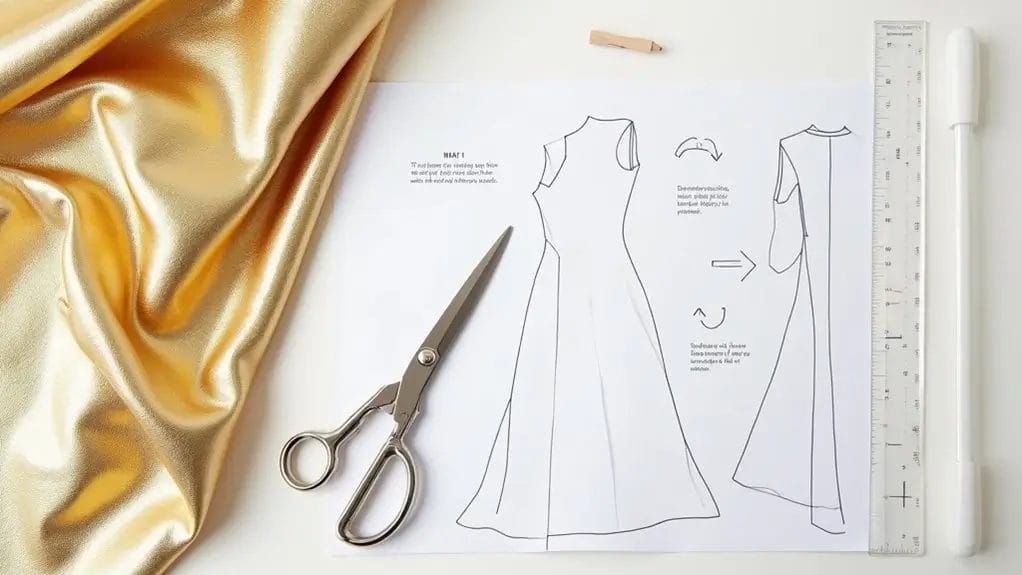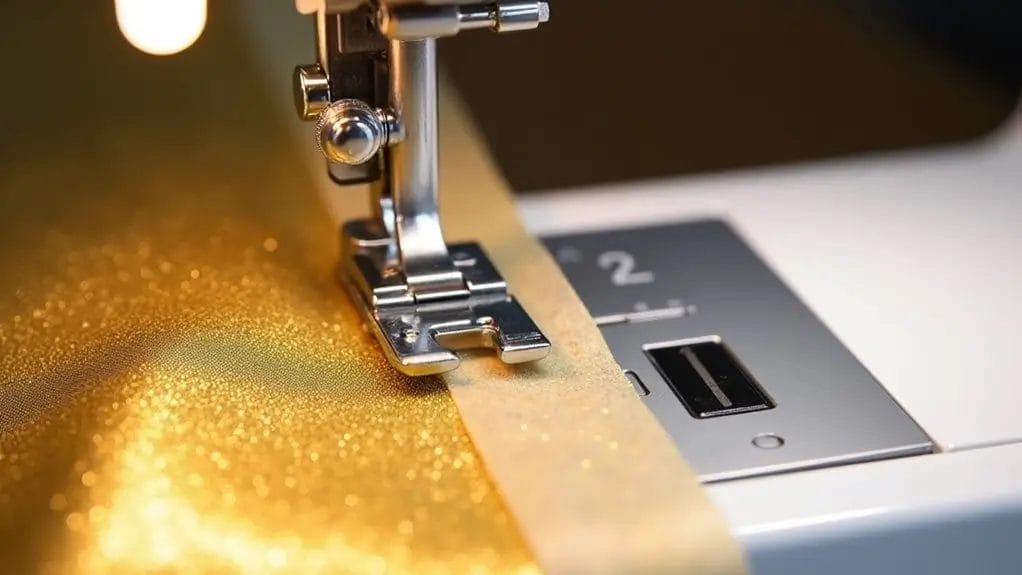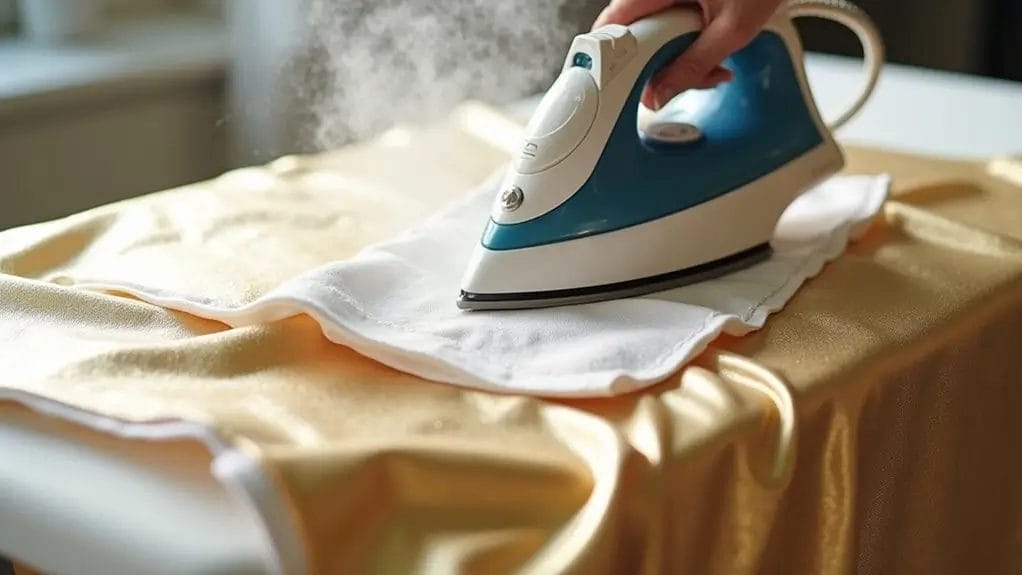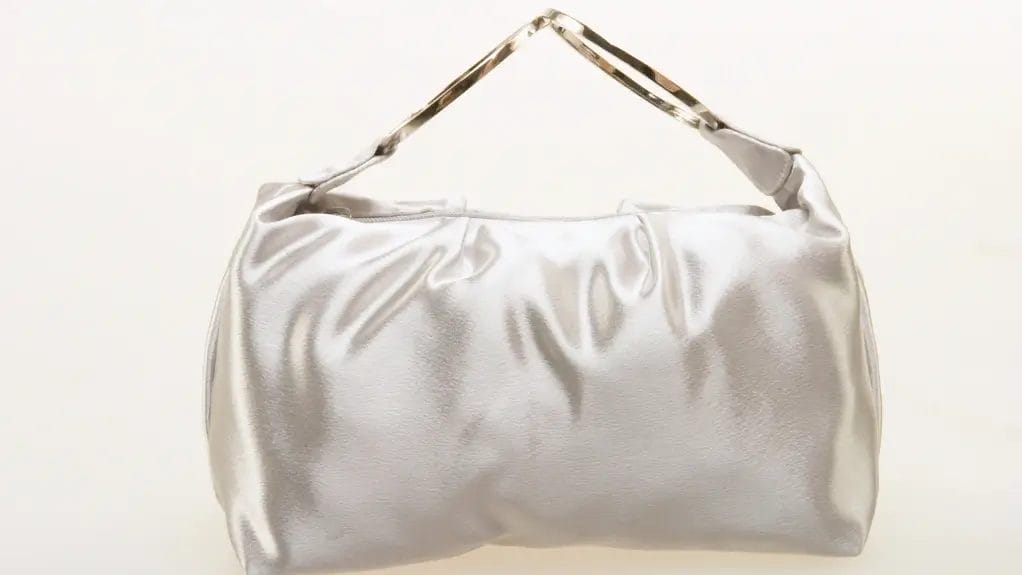If you've ever admired the shimmer of lamé fabric but felt intimidated about sewing with it, you're not alone. This luxurious metallic material can transform your projects into stunning pieces.
However, specific techniques are required to handle it properly. You'll need the right tools and methods to prevent damage to the delicate metallic threads while creating professional-looking results.
Let's explore the essential steps to help you master how to sew lame fabric.
Key Takeaways
- Use a fine needle (size 70/10 or 80/12) with polyester thread to prevent damage to the delicate metallic fibers.
- Replace traditional pins with fabric clips to avoid leaving permanent holes in the lamé fabric.
- Set your sewing machine's stitch length between 2.5 and 3.0 mm and reduce tension for smooth, even stitches.
- Work with a Teflon or walking foot to prevent the fabric from sticking or slipping during sewing.
- Press with low heat using a pressing cloth, and never pre-wash lamé fabric to maintain its metallic appearance.
Characteristics of Lamé Fabric
Lamé fabric, often called a modern "cloth of gold," is woven with fine metal fibers—usually in gold or silver tones—that give it a distinctive, shimmering appearance. One popular type, tissue lamé, is very lightweight and delicate, resembling the thinness of tissue paper but with a metallic finish. This makes it ideal for elegant apparel where a flowing drape is desired.
Lamé can also feature iridescent or hologram effects by combining metallic threads with synthetic fibers like nylon or mylar. However, due to its metallic content, lamé can sometimes tarnish over time if not cared for properly.
When sewing lamé, special attention is needed to finish edges such as the hem. Techniques like applying bias tape or using a specialized presser foot help prevent fraying and slipping. Lamé’s unique texture and shine make it a favorite for dramatic garments. But its delicate nature means sewing projects like a loose top require careful handling to maintain the fabric’s beauty and integrity.
Essential Tools and Materials for Working With Lamé
Gathering the right tools before you work with lamé fabric will make your sewing project much smoother and more successful.
You'll need a fine needle (size 70/10 or 80/12) and polyester thread as your foundation supplies.
For smooth fabric feeding, install a Teflon foot on your machine. Set your stitch length between 2.5 and 3.0 mm. Instead of pins, use clips to hold your fabric pieces together. Keep fusible interfacing handy to add stability to your project.
For seam finishing, you'll want access to both a zigzag stitch and an overlock stitch option. These will prevent your lamé from fraying at the edges.
Proper Cutting and Pattern Layout Techniques

When working with lamé fabric, laying out your pattern pieces correctly is essential for achieving professional results. You'll need to handle with care and maintain accuracy throughout the cutting process. So you can avoid slipping and damaging the delicate material.
- Prepare your cutting surface and lay the fabric in a single layer.
- Position pattern weights or clips instead of pins to secure your pattern pieces.
- Pay close attention to fabric grain when arranging your layout.
- Use extra-sharp scissors for clean, precise cuts.
Before you cut metallic fabric, make certain you're working on a clean, flat surface.
Remember to use a pressing cloth when needed. Take your time with the layout techniques to guarantee the best outcome.
Best Practices for Pinning and Marking
Lamé fabric can be easily damaged by traditional pinning methods. So you'll need to take special precautions when securing and marking your pattern pieces. Instead of pins, use fabric clips along the edges to hold your metallic fabric in place. And rely on pattern weights to keep pieces stable while cutting.
For marking, opt for tailor's chalk or washable fabric markers that won't leave permanent marks on your fabric. Make small, precise marks on the wrong side of the fabric where you'll need to match seams or add details.
When you're ready to sew, these marks will help guide your stitch length and guarantee proper seam alignment without damaging your delicate fabric.
Sewing Machine Settings and Stitching Methods

The proper sewing machine settings make all the difference when working with lamé fabric. Adjust your machine carefully to prevent damage to this delicate material while ensuring strong, even stitches.
- Install a thin needle (size 70/10 or 80/12) and use polyester thread for durability.
- Set your stitch length between 2.5 and 3.0 mm.
- Attach a walking foot to prevent fabric slipping.
- Reduce your tension slightly to accommodate the fabric's metallic surface.
For best results, test your settings on a scrap piece first. Consider using fusible interfacing for added stability, and remember that zigzag stitches work well for seam finishing.
If you're adding decorative elements, metallic thread can create stunning effects.
Pressing and Care Instructions for Metallic Fabrics

Proper pressing and care techniques preserve the distinctive shimmer of metallic fabrics while extending their lifespan. When handling lamé fabric, don't pre-wash it since water and chemicals can damage the metallic fibers. Instead, spot clean when necessary.
| Care Method | Do's | Don'ts |
|---|---|---|
| Pressing | Use a pressing cloth | Direct iron contact |
| Temperature | Low heat setting | High temperature |
| Cleaning | Spot clean only | Machine washing |
Place a pressing cloth over your synthetic fibers and iron using gentle pressure to remove wrinkles. Always test on a small area first, and keep the iron moving to prevent scorching. Work from the wrong side of the fabric whenever possible.
Troubleshooting Common Problems
Even with the best preparation, sewing lamé fabric can come with a few challenges. Here are some common issues you might encounter and how to solve them:
Fabric Puckering or Gathering
If your lamé textile puckers along the seams or gathers unevenly, it usually means your machine tension is too tight or the stitch length is too short.
To fix this, loosen the tension slightly and increase your stitch length to between 2.5 and 3.0 mm. Using a walking foot can also help feed the fabric evenly and prevent puckering.
Metallic Threads Breaking
Metallic threads are delicate; if they keep breaking while you sew, check that you’re using a fine needle (size 70/10 or 80/12) and polyester thread.
Sewing too fast or with a needle that’s too thick can cause thread breakage. Slow down your stitching speed and replace the needle if it becomes dull.
Fabric Slipping or Shifting
Eye-catching lamé can be slippery, causing your fabric layers to move out of alignment as you sew.
To keep everything in place, use fabric clips instead of pins when holding pieces together. Also, a Teflon or walking foot on your sewing machine will help feed the fabric smoothly without slipping.
Visible Pin Holes or Marks
Traditional pins can leave permanent holes in lamé fabric, which are hard to hide. Always opt for fabric clips or pattern weights during cutting and sewing.
To avoid leaving permanent marks, mark with tailor’s chalk or washable markers on the wrong side of the fabric.
Seams Fraying
Because lamé tends to fray easily, finishing your seams properly is essential. Use a zigzag or an overlock stitch along raw edges to keep your garment neat and prevent unraveling.
Recognizing these issues early and applying these simple fixes will keep your lamé projects running smoothly and looking their best.
Creative Project Ideas with Lamé Fabric

Lamé fabric adds sparkle and glamour to any project. These ideas are simple ways to use its shine. Try them to build your skills and creativity.
- Glamorous Evening Wear: Use lamé fabric to create a stunning dress perfect for formal events.
- Shimmering Skirt: Sew an A-line or pencil skirt that highlights lamé’s metallic shine.
- Metallic Blouse or Top: Add lamé sleeves or bodice panels for a bold statement piece.
- Stylish Clutch or Purse: Craft a small, sparkly handbag using lamé as the main fabric.
- Festive Scarves and Wraps: Make lightweight scarves that bring shimmer to any outfit.
- Decorative Hair Accessories: Use lamé scraps to create eye-catching headbands or bows.
- Holiday or Costume Pieces: Design costumes or dancewear that benefit from lamé’s dramatic shine.
Final Words: How to Sew Lame Fabric
You're now equipped to tackle lamé fabric projects with confidence. Remember to keep your tools sharp, maintain proper machine settings, and handle the fabric gently to preserve its metallic beauty.
While working with lamé fabric requires extra attention, following these techniques makes the process manageable and rewarding.
With practice, you'll create stunning garments that showcase lamé's unique shimmer and elegance.
Learn more sewing tips on the Longan Craft Blog, and dive into the fabric world with Longan Craft!
FAQs
Can Lamé Fabric Be Used for Outdoor Garments Exposed to Rain?
You shouldn't use lamé fabric for rain-exposed outdoor garments. It's not water-resistant, and moisture can damage the metallic finish. The fabric's delicate nature makes it better suited for indoor and special occasion wear.
How Long Does the Metallic Finish Typically Last With Regular Wear?
Your metallic finish will typically last 1-2 years with regular wear. The lifespan depends on how you care for it—gentle washing, avoiding harsh detergents, and proper storage will extend its durability.
Is It Possible to Dye Lamé Fabric Without Damaging the Metallic Finish?
You can't dye lamé fabric, as the dyeing process will damage or destroy the metallic finish. It's best to purchase the fabric in your desired color to maintain its metallic properties.
Can Lamé Fabric Be Successfully Altered or Resized After Construction?
You'll find lamé alterations challenging since the fabric shows pin marks and doesn't recover well from unpicking. While minor adjustments are possible, it's best to guarantee proper fit before construction to avoid extensive modifications.


0 comments